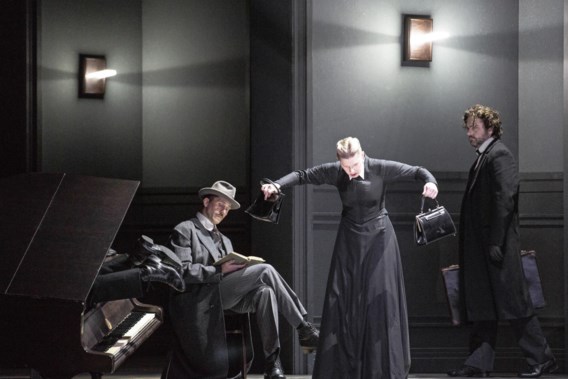Review Opera
© Bernd Uhlig
Andrea Breth’s cinematic direction van The turn of the screwraises more questions than it answers. Good choice. Because as a spectator you involuntarily color the dramatic white space with your own horror images: a nightmare like a connect-the-dots puzzle.
The turn of the screw
Andrea Breth
Until May 14 in De Munt
With this revisit of a production that already visited De Munt in the covid year 2021, but could only be experienced online, lovers of the gothic novel still get the chance to be spooked by the iconic ghost story by the American-English author Henry James. published in 1898. Adaptations of the bestseller sprang up like mushrooms in the middle of the last century – from television series to films, plays and ballets to a Broadway musical. And opera, that is. Benjamin Britten scored with The turn of the screw (1954) on libretto by Myfanwy Piper, a super hit, which, together with Peter Grimes, forms the pinnacle of his stage portfolio.
The uncanny chronicle is about a governess who takes two children into her care, under the strict conditions of never leaving them alone in the dark corridors of the Bly estate and not asking their mysterious guardian for explanations. The turnstile starts turning at a very dramatic pace. Because nothing is what it seems and no one turns out to be innocent. Including the children, who are in the stranglehold of Peter Quint and Miss Jessel: two deceased servants with a stained past. Housekeeper Mrs Grose could have been an omniscient narrator – she clearly knows more about the traumas of the estate – but remains tight-lipped. We never find out exactly what happened (rape? pedophilia?); it is just one of the questions that festers until the ultimate cataclysm destroys hope, truth and innocence.
© Bernd Uhlig
Spoken of voyeurs?
Breth makes no attempt to unveil the enigma. She celebrates ambiguity and adds layers of meaning by playing with symbols and patterns: a code that you as a spectator try in vain to crack. Through a labyrinth of rooms, moving walls and towering wardrobes, the stage also offers access to something dark – straight from our subconscious, or worse: from a possible reality. The singing cast only has a handful of protagonists, but there are more people on stage. Men in dark suits, women in long dresses. Ghosts, echoes, duplicates, voyeurs or co-creators of evil? Breth also leaves that open.
In the role of the young Miles, two singers from the children’s choir of De Munt skillfully maneuver through Britten’s hurried writing and the subtle excesses of Breth’s direction. We think Katharina Bierweiler, the twenty-year-old singer who plays Flora, is one to follow: style and substance plus a powerful but elegant soprano who uses the vibrato as an ornament, not as a dramatic device. The thirteen-piece chamber orchestra does a great job in Britten’s atmospheric, but brutally virtuosic score. Special mention for the soloist on tubular bells who creates a beautiful soundscape during a grisly procession.
Reasons enough to rise from the comfort of your bed after a manageable two hours. Why don’t we give it a standing ovation? In the orchestra pit there was still some room for contrast and momentum, the stage cast played the hysteria card too easily. That is personal taste, but also a matter of tension: if the screw is tightened tightly from the start, there is a real chance of metal fatigue.
© Bernd Uhlig
© Bernd Uhlig
#Doityourself #horror #opera #turn #screw #iconic #ghost #story #vain #fill
– 2024-05-03 23:16:07


